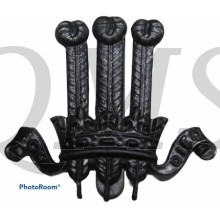2nd King Edward VII's Own Gurkha Rifles (The Sirmoor Rifles)
The 2nd King Edward VII's Own Gurkha Rifles (The Sirmoor Rifles) was a rifle regiment of the British Indian Army before being transferred to the British Army comprising Gurkha soldiers of Nepalese origin on India's independence in 1947. The 4th Battalion joined the Indian Army as the 5th Battalion, 8th Gurkha Rifles (Sirmoor Rifles), where it exists to this day. As part of the British Army, the regiment served in Malaya, Hong Kong and Brunei until 1994 when it was amalgamated with the other three British Army Gurkha regiments to form the Royal Gurkha Rifles. It is the only Gurkha regiment which did not have Khukuri on its cap badge.
The Second World War saw the 2nd Gurkhas serving in many different theatres; the 1st Battalion was initially in Cyprus before moving to North Africa as part of 7th Indian Infantry Brigade, 4th Indian Division, where it fought at El Alamein. Following this it took part in the invasion of Italy, taking part in the battle for Monte Cassino. The 2nd Battalion meanwhile spent much of the war as prisoners of the Japanese after being captured in Malaya. The 3rd Battalion (raised during the war) took part in the Chindit operations inBurma in 1943.
The Second World War:
El Alamein, Mareth, Akarit, Djebel el Meida, Enfidaville, Tunis, North Africa 1942–43, Cassino I, Monastery Hill, Pian di Maggio, Gothic Line, Coriano, Poggio San Giovanni, Monte Reggiano, Italy 1944–45, Greece 1944–45, North Malaya, Jitra, Central Malaya, Kampar, Slim River, Johore, Singapore Island, Malaya 1941–42, North Arakan, Irrawaddy, Magwe, Sittang 1945, Point 1433, Arakan Beaches, Myebon, Tanbingon, Tamandu, Chindits 1943, Burma 1943–45.





